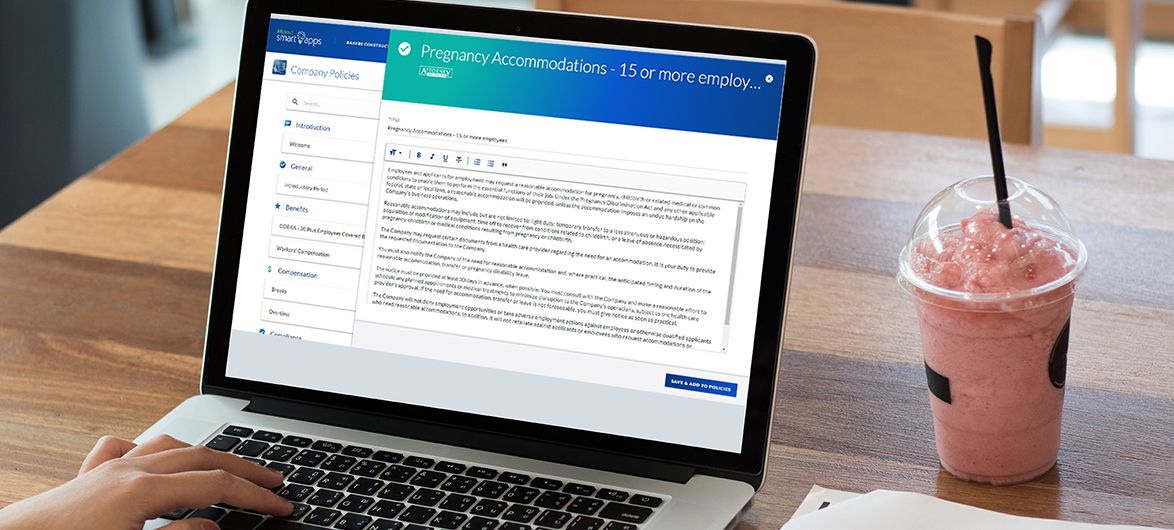Have you ever thought, “My business is too small to need an employee handbook?” If so, you may want to think again.
It’s a best practice for businesses of all sizes to have personnel policies. Simply put, having a company handbook is critical because it tells employees what you expect from them – and what they should expect from you. It defines boundaries, establishes ground rules and explains what is (and is not) acceptable behavior.
It doesn’t matter if your handbook is printed or online. Electronic handbooks are perfectly acceptable – as long as all employees have access.
5 Reasons to Establish Formal Company Policies and Procedures
There are no specific laws requiring you to have a handbook. However, employee handbooks are an effective way to share critical company information, while providing several other key benefits for employers. For example, personnel policies establish:
- Legal protection: By clearly stating your employment policies and expectations, handbooks can protect your business against lawsuits. For example, if your handbook includes language that “no-calls/no-shows” are cause for discipline, employees violating the policy will find it difficult to prove they were punished unfairly.
- Open communication: Employees expect employers to communicate and share important information with them. A handbook demonstrates your business values this type of communication.
- Behavioral standards: Your handbook can outline the behavior your company finds acceptable and, just as important, the behavior that is unacceptable. Describing disciplinary action also informs employees of the consequences if they fail to uphold these standards.
- Fair treatment: While it’s not realistic for handbooks to offer precise instructions on every problem, they should provide a solid framework for managers to follow. This way, all employees are treated fairly and consistently which, again, can help protect you against lawsuits.
- Policy improvements: The process of writing a handbook forces you to think through and evaluate your employee policies. By taking the time to put everything in writing, you can select the best benefits for employees, narrow down the most effective ways to manage employees, and identify potential problems long before they take up valuable time or resources.
6 Essential Policies to Include in Your Handbook
Of course, handbooks are only useful if they contain valuable and accurate information. Here’s what you should include in your employee handbook:
- Company mission or values: Stating your company’s priorities can help define culture and the type of behavior you expect from employees.
- Required notices: Include any policies you are required to put in writing, such as being an equal opportunity employer, having a drug-free workplace or providing a non-smoking environment.
- Core policies: There are many policies a handbook should contain. At a minimum, include policies on at-will employment, attendance, harassment and basic conduct. This is only a short list to get you started.
- Work information: Basic information on time and pay should be covered in your handbook. Payroll schedules, normal working hours for full-time employees, rules for part-time employees and approval processes for overtime pay for covered employees, for example, are all appropriate policies.
- Benefits: Explain any rules related to the benefits you offer employees, such as paid time off or unpaid leave. Include details on your time off request procedure, as well. For benefits run by outside providers (insurance plans, for example), list the provider and how the employee can get official plan documents.
- Discipline: Outline the types of unacceptable conduct – violence, theft or repeated performance problems, for example – that can get employees in trouble, along with your company’s basic disciplinary process.
This list only covers what you should include at a minimum. Depending on your location or industry, you may be required to include more notices.

Here are some additional policy pointers:
- Keep language simple and succinct and avoid business jargon. The goal is to communicate clearly so all employees understand the goals and expectations.
- Make sure your handbook is readable. Use bullets, subheads and ample space between paragraphs so employees can quickly refer back to a section. It should be easy for workers to get the information they need.
- Don’t let your handbook be a substitute for personal communication. Your policies should serve as a guide for employees, but you should still discuss them with your staff – and be available to answer questions or provide clarification.
Handbook Help is Here
The web-based Company Policies Smart App provides recommended policies for businesses to implement based on federal and state laws. Each policy is attorney-approved and editable, so you can add specific details and make changes that pertain to your business. Notifying employees of new policies is simple, too. Just as important, you can view when employees have read and acknowledged your policies.
- Formal personnel policies are recommended for businesses of all sizes.
- Employee handbooks are an effective way to share critical company information.
- Putting company policies in writing helps set employee expectations and reduce misunderstandings.
- Formal policies can protect your business in the event of an employee dispute.
- The Company Policies Smart App gives you an easy way to create your handbook with attorney-approved policies.






